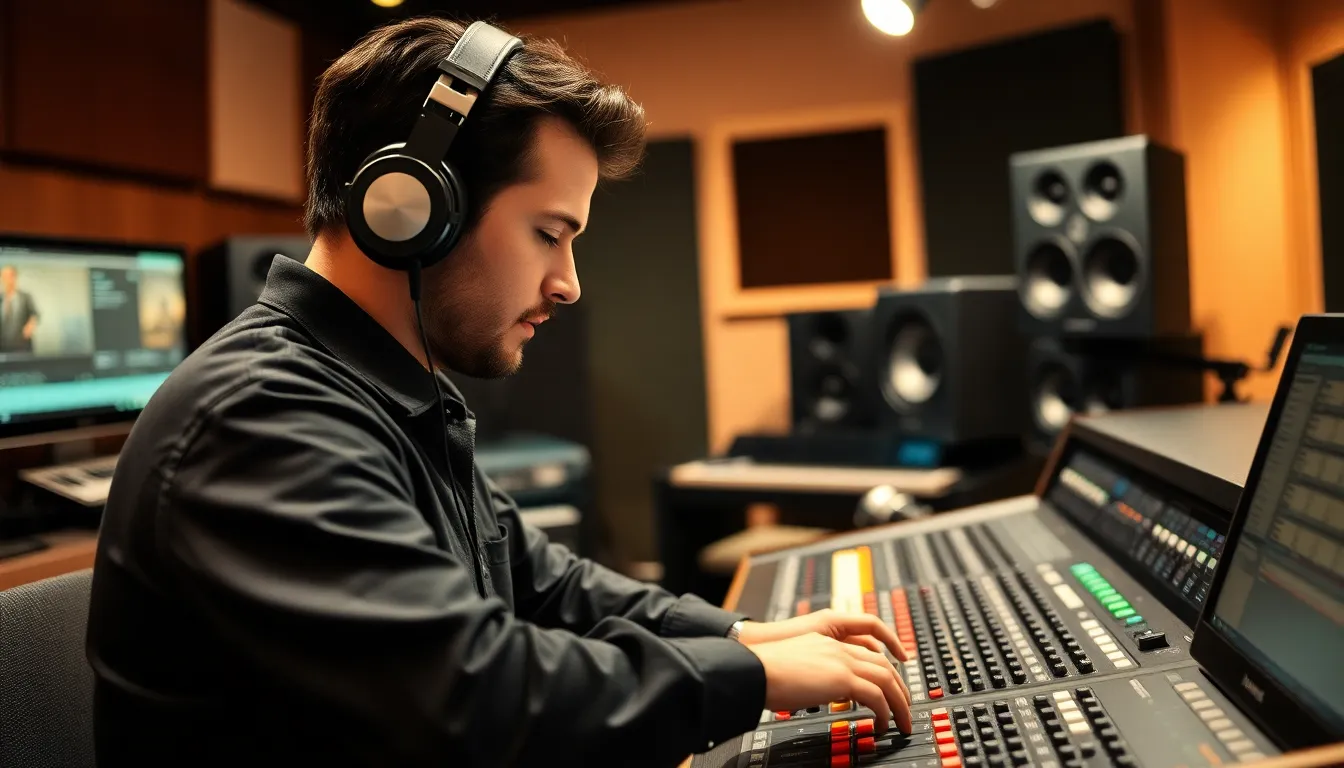Imagine watching your favorite movie without sound. It’s like a pizza without cheese—just not right. Cinematic audio is the unsung hero of filmmaking, transforming ordinary scenes into unforgettable experiences. From the subtle rustle of leaves to the heart-pounding score during a climactic moment, audio shapes the story in ways visuals alone can’t.
Table of Contents
ToggleOverview of Cinematic Audio
Audio plays a vital role in filmmaking, enriching the viewing experience through immersive sound design. Various audio elements create an emotional connection, elevating scenes into unforgettable moments.
Definition and Importance
Cinematic audio encompasses all sound elements in film, including dialogue, music, and sound effects. Its importance lies in the way it shapes viewers’ perceptions. High-quality audio influences emotional responses and engagement levels. Sound can enhance narrative clarity, making dialogues understandable. In addition, effectively used background scores heighten tension, joy, and sadness. Examples of impactful audio include the stirring soundtrack of “Star Wars” or the haunting sounds in “A Quiet Place,” both of which demonstrate audio’s powerful effect on storytelling.
Evolution of Sound in Film
The evolution of sound in film dates back to the silent era, where live music accompanied screenings. The introduction of synchronized sound in the late 1920s changed filmmaking dramatically. Films like “The Jazz Singer” marked the transition to talkies, increasing audience engagement. As technology advanced, filmmakers began experimenting with surround sound systems in the 1970s. Innovations such as Dolby’s Atmos technology have since allowed immersive audio experiences. Today, sound design integrates seamlessly with visuals, creating a more cohesive storytelling approach.
Types of Cinematic Audio

Cinematic audio includes various elements vital for storytelling. Two major categories shape the viewer’s experience: diegetic and non-diegetic sound, alongside the rich layer of ambient soundscapes.
Diegetic vs. Non-Diegetic Sound
Diegetic sound refers to audio elements that originate from within the film’s world. Characters can hear this sound, such as dialogues, footsteps, or music from a radio. Non-diegetic sound, however, exists outside the film’s narrative. This category includes background music or voiceovers that only the audience perceives. Each type serves its purpose, enhancing emotional responses and narrative delivery. Understanding the distinctions between these sounds clarifies how audio contributes to viewer immersion.
Ambient Soundscapes
Ambient soundscapes create a backdrop that enriches the film’s setting. This audio includes environmental sounds, like rustling leaves or distant traffic. Such sounds establish atmosphere, adding depth to scenes. Different settings may require unique soundscapes, from the calm of a forest to the hustle of a city. Sound designers meticulously craft these layers to evoke sensations and establish context. Overall, ambient soundscapes form an essential part of cinematic audio, grounding the story in a believable environment.
Techniques in Cinematic Audio Production
Cinematic audio production employs various techniques to elevate storytelling and enhance viewer experience.
Sound Design Principles
Emphasizing clarity is crucial in sound design. Designers create an audio landscape that complements visual elements without overshadowing them. Utilizing layers of sounds deepens emotional engagement, while precise timing aligns audio cues with visual action. Focusing on the importance of sound textures enriches scenes, with distinct auditory elements establishing mood. Balancing levels among dialogue, music, and effects maximizes impact, ensuring each element contributes effectively to the narrative. Audiences will perceive an immersive world when filmmakers integrate these design principles seamlessly.
Mixing and Mastering for Film
Mixing involves adjusting audio levels and balancing various sound elements. Editors must carefully position sounds in the stereo field to enhance depth. Utilizing equalization can emphasize or reduce specific frequencies, refining clarity. Mastering finalizes audio before distribution by ensuring consistency across all playback systems. It focuses on optimizing loudness for theatrical releases and streaming platforms. Filmmakers should prioritize dynamic range to maintain emotional power in films, providing a rich listening experience for viewers. Adjustments must be made to meet the technical standards of different formats, enhancing overall presentation.
Tools and Technologies
Cinematic audio relies on various tools and technologies that facilitate the integration of sound into film, enhancing the overall experience.
Digital Audio Workstations (DAWs)
Digital Audio Workstations, or DAWs, serve as essential platforms for audio editing and production. These software applications enable sound professionals to compose, record, and edit audio tracks with precision. Popular DAWs include Pro Tools, Logic Pro, and Ableton Live, each offering unique features tailored for film sound design. Editing is streamlined within DAWs, allowing for seamless manipulation of audio elements. Tools like automation and MIDI support expand creative possibilities for filmmakers. Accurate visual representation of waveforms aids in synchronizing audio to video.
Sound Libraries and Plugins
Sound libraries and plugins contribute significantly to cinematic audio production. Extensive libraries provide pre-recorded sound effects, ambient noises, and musical compositions. These libraries, such as Soundsnap and Splice, offer diverse options to enhance the sonic landscape of a film. Additionally, plugins enhance the capabilities of DAWs by adding effects like reverb, compression, and equalization. Popular plugins such as Waves and iZotope are frequently utilized by sound engineers to refine audio quality. Customizable parameters allow for precise control over sound characteristics. Access to high-quality sounds enriches the auditory experience, providing filmmakers tools for immersive storytelling.
Case Studies in Cinematic Audio
Examining notable instances in cinematic audio reveals how sound transforms film narratives. These case studies highlight the impact of sound design on viewer experience and emotional engagement.
Iconic Films and Their Soundtracks
“Star Wars” showcases a masterful blend of orchestral score and innovative sound effects. John Williams’ compositions intertwine with iconic sound elements, like the lightsaber’s hum and the TIE fighter’s roar, enhancing the film’s epic narrative. “Inception” exemplifies the use of sound as a storytelling device. The film employs a powerful score by Hans Zimmer and the “braaam” sound that punctuates key moments, immersing viewers in a dreamlike atmosphere. “The Lion King” combines music and sound effects, forging a strong emotional connection. Elton John’s songs and the rich ambient sounds of the savannah deepen the viewer’s experience, evoking nostalgia.
Innovations in Recent Cinema
Recent films demonstrate advancements in audio technology that elevate cinematic experiences. “A Quiet Place” employs silence as a critical narrative element. The film’s minimalistic sound design enhances suspense, engaging audiences in a unique way. Dolby Atmos technology features prominently in films like “Dunkirk,” creating a surround sound experience that envelops viewers. Through precise audio placement, filmmakers manipulate soundscapes to reflect characters’ emotions. “Tenet” utilizes layered sound to convey complex themes. The dynamic shifts in sound correlate with the film’s time manipulation, creating an immersive sensory experience that captivates audiences.
Cinematic audio is a powerful tool that shapes the way stories are told on screen. By blending various sound elements filmmakers create immersive experiences that resonate emotionally with audiences. The evolution of sound technology has paved the way for innovative storytelling techniques that enhance narrative depth and clarity.
As sound design continues to advance filmmakers can expect even greater possibilities for audio integration in their projects. The impact of well-crafted audio can’t be overstated; it elevates films from mere visuals to rich sensory experiences that linger in viewers’ minds long after the credits roll. Embracing the art of cinematic audio is essential for anyone looking to create compelling and memorable films.








